Systems of Linear Equations
Graphing Systems of Linear Inequalities
Learning Objectives
By the end of this section, you will be able to:
- Determine whether an ordered pair is a solution of a system of linear inequalities
- Solve a system of linear inequalities by graphing
- Solve applications of systems of inequalities
Before you get started, take this readiness quiz.
Determine whether an ordered pair is a solution of a system of linear inequalities
The definition of a system of linear inequalities is very similar to the definition of a system of linear equations.
Two or more linear inequalities grouped together form a system of linear inequalities.
A system of linear inequalities looks like a system of linear equations, but it has inequalities instead of equations. A system of two linear inequalities is shown here.
To solve a system of linear inequalities, we will find values of the variables that are solutions to both inequalities. We solve the system by using the graphs of each inequality and show the solution as a graph. We will find the region on the plane that contains all ordered pairs ![]() that make both inequalities true.
that make both inequalities true.
Solutions of a system of linear inequalities are the values of the variables that make all the inequalities true.
The solution of a system of linear inequalities is shown as a shaded region in the x, y coordinate system that includes all the points whose ordered pairs make the inequalities true.
To determine if an ordered pair is a solution to a system of two inequalities, we substitute the values of the variables into each inequality. If the ordered pair makes both inequalities true, it is a solution to the system.
Determine whether the ordered pair is a solution to the system ![]()
ⓐ![]() ⓑ
ⓑ![]()
ⓐ Is the ordered pair ![]() a solution?
a solution?

The ordered pair ![]() made both inequalities true. Therefore
made both inequalities true. Therefore ![]() is a solution to this system.
is a solution to this system.
ⓑ Is the ordered pair ![]() a solution?
a solution?

The ordered pair ![]() made one inequality true, but the other one false. Therefore
made one inequality true, but the other one false. Therefore ![]() is not a solution to this system.
is not a solution to this system.
Determine whether the ordered pair is a solution to the system: ![]()
ⓐ![]() ⓑ
ⓑ![]()
ⓐ no ⓑ yes
Determine whether the ordered pair is a solution to the system: ![]()
ⓐ![]() ⓑ
ⓑ![]()
ⓐ yes ⓑ no
Solve a System of Linear Inequalities by Graphing
The solution to a single linear inequality is the region on one side of the boundary line that contains all the points that make the inequality true. The solution to a system of two linear inequalities is a region that contains the solutions to both inequalities. To find this region, we will graph each inequality separately and then locate the region where they are both true. The solution is always shown as a graph.
Solve the system by graphing: ![]()
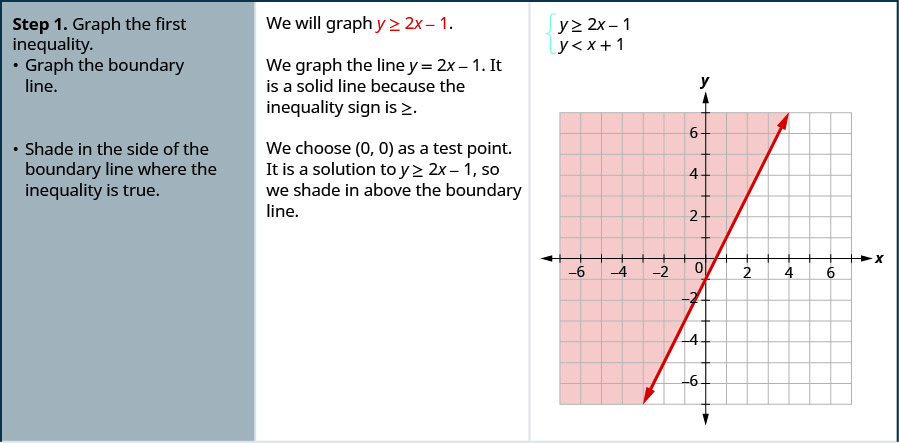
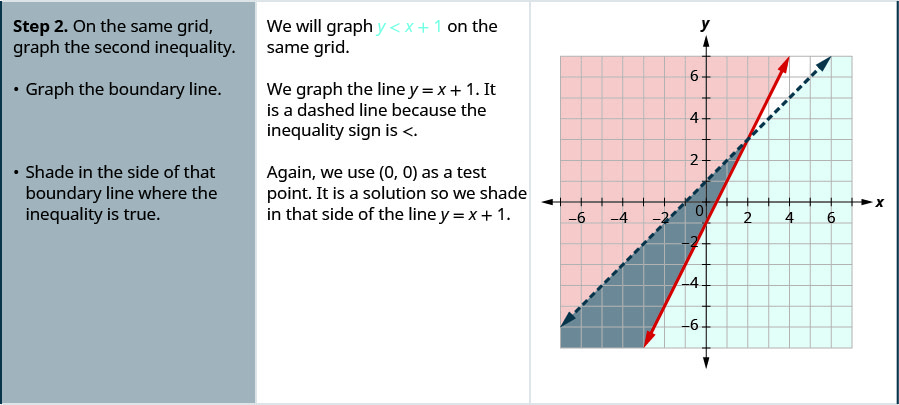

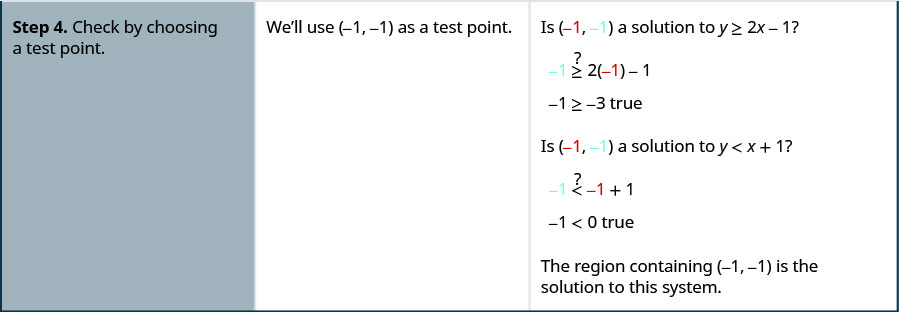
Solve the system by graphing: ![]()
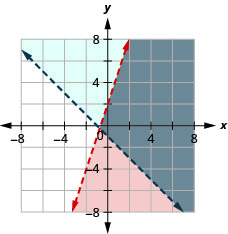
The solution is the grey region.
Solve the system by graphing: ![]()
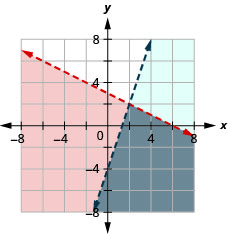
The solution is the grey region.
- Graph the first inequality.
- Graph the boundary line.
- Shade in the side of the boundary line where the inequality is true.
- On the same grid, graph the second inequality.
- Graph the boundary line.
- Shade in the side of that boundary line where the inequality is true.
- The solution is the region where the shading overlaps.
- Check by choosing a test point.
Solve the system by graphing: ![]()
| Graph x − y > 3, by graphing x − y = 3
and testing a point. The intercepts are x = 3 and y = −3 and the boundary line will be dashed. Test (0, 0) which makes the inequality false so shade (red) the side that does not contain (0, 0). |
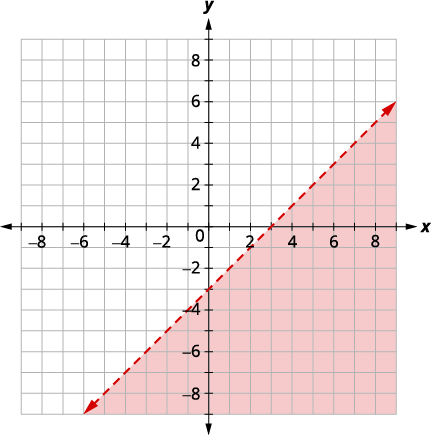 |
| Graph using the slope The boundary line will be dashed Test (0, 0) which makes the inequality true, so shade (blue) the side that contains (0, 0). Choose a test point in the solution and verify that it is a solution to both inequalties. |
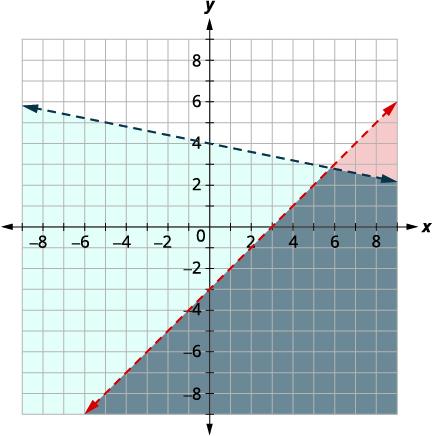 |
The point of intersection of the two lines is not included as both boundary lines were dashed. The solution is the area shaded twice—which appears as the darkest shaded region.
Solve the system by graphing: ![]()
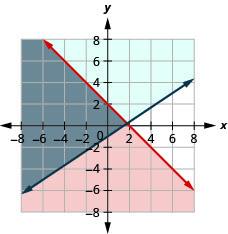
The solution is the grey region.
Solve the system by graphing: ![]()
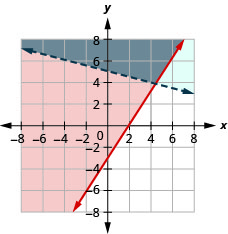
The solution is the grey region.
Solve the system by graphing: ![]()
| Graph and testing a point. The intercepts are x = 5 and y = −2.5 and the boundary line will be dashed. Test (0, 0) which makes the inequality true, so shade (red) the side that contains (0, 0). |
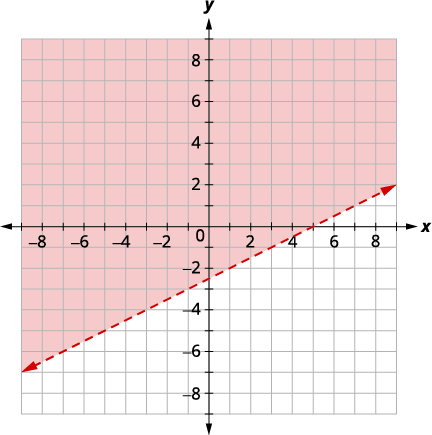 |
| Graph recognizing that it is a horizontal line through be dashed. Test (0, 0) which makes the inequality true so shade (blue) the side that contains (0, 0). |
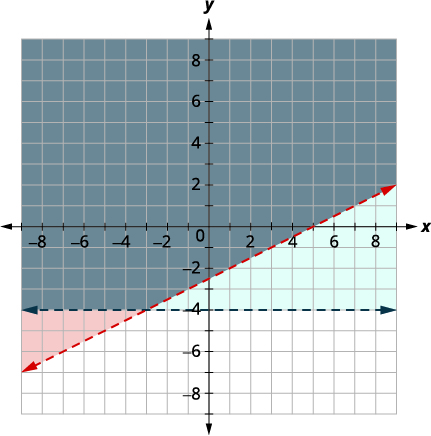 |
The point ![]() is in the solution and we have already found it to be a solution of each inequality. The point of intersection of the two lines is not included as both boundary lines were dashed.
is in the solution and we have already found it to be a solution of each inequality. The point of intersection of the two lines is not included as both boundary lines were dashed.
The solution is the area shaded twice—which appears as the darkest shaded region.
Solve the system by graphing: ![]()
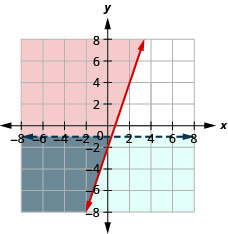
The solution is the grey region.
Solve the system by graphing: ![]()
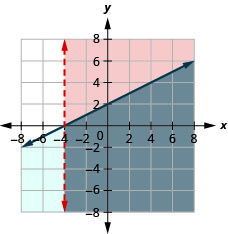
The solution is the grey region.
Systems of linear inequalities where the boundary lines are parallel might have no solution. We’ll see this in the next example.
Solve the system by graphing: ![]()
| Graph and testing a point. The intercepts are x = 3 and y = 4 and the boundary line will be solid. Test (0, 0) which makes the inequality false, so shade (red) the side that does not contain (0, 0). |
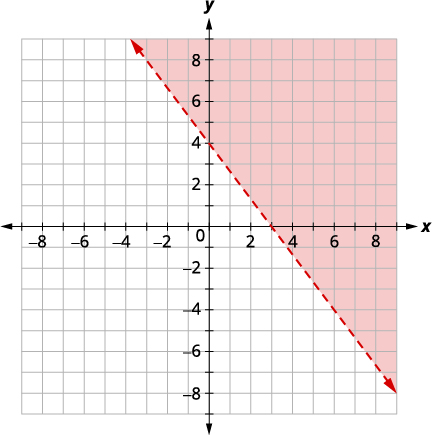 |
| Graph using the slope b = 1. The boundary line will be dashed. Test (0, 0) which makes the inequality true, so shade (blue) the side that contains (0, 0). |
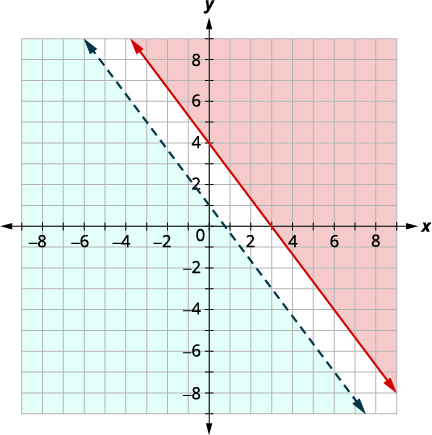 |
There is no point in both shaded regions, so the system has no solution.
Solve the system by graphing: ![]()
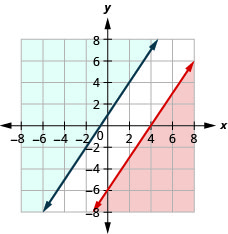
No solution.
Solve the system by graphing: ![]()
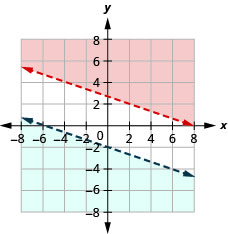
No solution.
Some systems of linear inequalities where the boundary lines are parallel will have a solution. We’ll see this in the next example.
Solve the system by graphing: ![]()
| Graph using the slope b = −4. The boundary line will be dashed. Test (0, 0) which makes the inequality true, so shade (red) the side that contains (0, 0). |
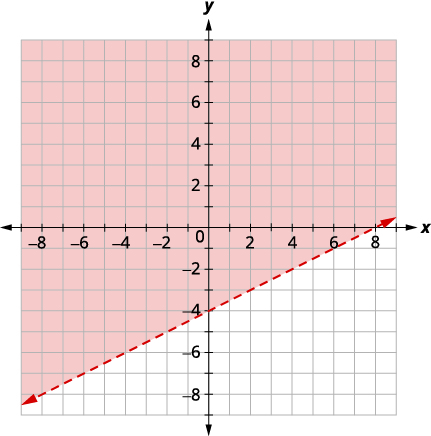 |
| Graph and testing a point. The intercepts are x = −4 and y = 2 and the boundary line will be dashed. Choose a test point in the solution and verify that it is a solution to both inequalties. Test (0, 0) which makes the inequality false, so shade (blue) the side that does not contain (0, 0). |
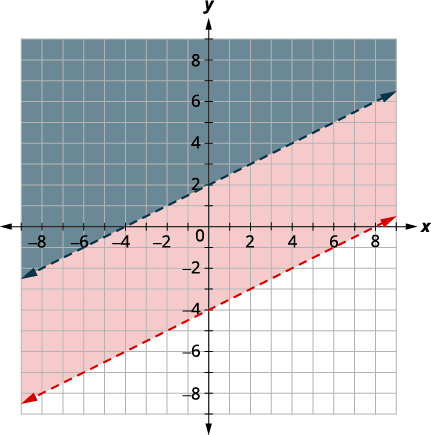 |
No point on the boundary lines is included in the solution as both lines are dashed.
The solution is the region that is shaded twice which is also the solution to ![]()
Solve the system by graphing: ![]()
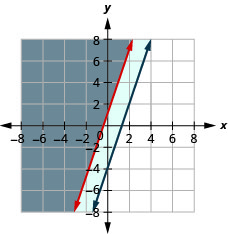
The solution is the grey region.
Solve the system by graphing: ![]()
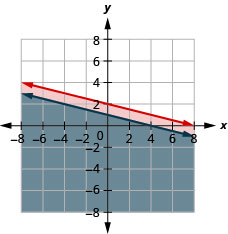
The solution is the grey region.
Solve Applications of Systems of Inequalities
The first thing we’ll need to do to solve applications of systems of inequalities is to translate each condition into an inequality. Then we graph the system, as we did above, to see the region that contains the solutions. Many situations will be realistic only if both variables are positive, so we add inequalities to the system as additional requirements.
Christy sells her photographs at a booth at a street fair. At the start of the day, she wants to have at least 25 photos to display at her booth. Each small photo she displays costs her ?4 and each large photo costs her ?10. She doesn’t want to spend more than ?200 on photos to display.
ⓐ Write a system of inequalities to model this situation.
ⓑ Graph the system.
ⓒ Could she display 10 small and 20 large photos?
ⓓ Could she display 20 large and 10 small photos?
ⓐ
![]()
To find the system of equations translate the information.
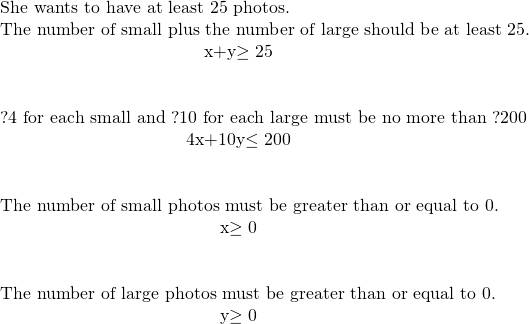
We have our system of equations.

ⓑ
Since ![]() and
and ![]() (both are greater than or equal to) all solutions will be in the first quadrant. As a result, our graph shows only quadrant one.
(both are greater than or equal to) all solutions will be in the first quadrant. As a result, our graph shows only quadrant one.
| To graph Choose (0, 0) as a test point. Since it does not make the inequality true, shade (red) the side that does not include the point (0, 0). To graph Choose (0, 0) as a test point. Since it does make the inequality true, shade (blue) the side that include the point (0, 0). |
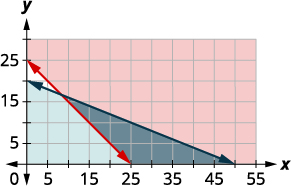 |
The solution of the system is the region of the graph that is shaded the darkest. The boundary line sections that border the darkly-shaded section are included in the solution as are the points on the x-axis from (25, 0) to (55, 0).
ⓒ To determine if 10 small and 20 large photos would work, we look at the graph to see if the point (10, 20) is in the solution region. We could also test the point to see if it is a solution of both equations.
It is not, Christy would not display 10 small and 20 large photos.
ⓓ To determine if 20 small and 10 large photos would work, we look at the graph to see if the point (20, 10) is in the solution region. We could also test the point to see if it is a solution of both equations.
It is, so Christy could choose to display 20 small and 10 large photos.
Notice that we could also test the possible solutions by substituting the values into each inequality.
A trailer can carry a maximum weight of 160 pounds and a maximum volume of 15 cubic feet. A microwave oven weighs 30 pounds and has 2 cubic feet of volume, while a printer weighs 20 pounds and has 3 cubic feet of space.
ⓐ Write a system of inequalities to model this situation.
ⓑ Graph the system.
ⓒ Could 4 microwaves and 2 printers be carried on this trailer?
ⓓ Could 7 microwaves and 3 printers be carried on this trailer?
ⓐ![]()
ⓑ
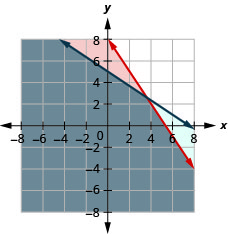
ⓒ yes
ⓓ no
Mary needs to purchase supplies of answer sheets and pencils for a standardized test to be given to the juniors at her high school. The number of the answer sheets needed is at least 5 more than the number of pencils. The pencils cost ?2 and the answer sheets cost ?1. Mary’s budget for these supplies allows for a maximum cost of ?400.
ⓐ Write a system of inequalities to model this situation.
ⓑ Graph the system.
ⓒ Could Mary purchase 100 pencils and 100 answer sheets?
ⓓ Could Mary purchase 150 pencils and 150 answer sheets?
ⓐ![]()
ⓑ
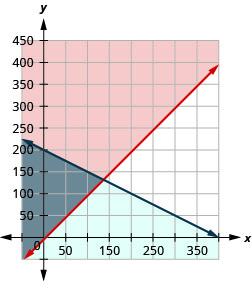
ⓒ no
ⓓ no
When we use variables other than x and y to define an unknown quantity, we must change the names of the axes of the graph as well.
Omar needs to eat at least 800 calories before going to his team practice. All he wants is hamburgers and cookies, and he doesn’t want to spend more than ?5. At the hamburger restaurant near his college, each hamburger has 240 calories and costs ?1.40. Each cookie has 160 calories and costs ?0.50.
ⓐ Write a system of inequalities to model this situation.
ⓑ Graph the system.
ⓒ Could he eat 3 hamburgers and 1 cookie?
ⓓ Could he eat 2 hamburgers and 4 cookies?
ⓐ
![]()
To find the system of equations translate the information.
The calories from hamburgers at 240 calories each, plus the calories from cookies at 160 calories each must be more that 800.
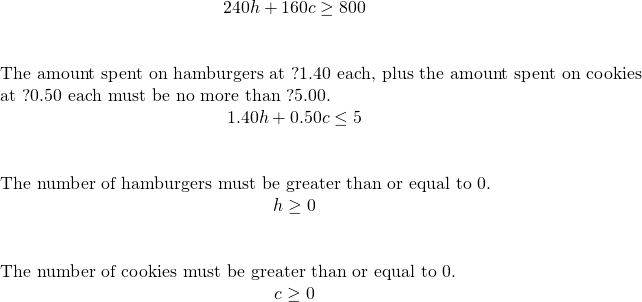

ⓑ
Since ![]() and
and ![]() (both are greater than or equal to) all solutions will be in the first quadrant. As a result, our graph shows only quadrant one.
(both are greater than or equal to) all solutions will be in the first quadrant. As a result, our graph shows only quadrant one.
| To graph Choose (0, 0) as a test point. Since it does not make the inequality true, shade (red) the side that does not include the point (0, 0). |
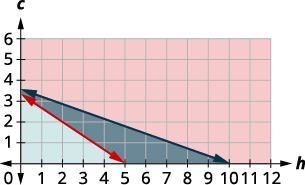 |
Graph ![]() The boundary line is
The boundary line is ![]() We test (0, 0) and it makes the inequality true. We shade the side of the line that includes (0, 0).
We test (0, 0) and it makes the inequality true. We shade the side of the line that includes (0, 0).
The solution of the system is the region of the graph that is shaded the darkest. The boundary line sections that border the darkly shaded section are included in the solution as are the points on the x-axis from (5, 0) to (10, 0).
ⓒ To determine if 3 hamburgers and 2 cookies would meet Omar’s criteria, we see if the point (3, 2) is in the solution region. It is, so Omar might choose to eat 3 hamburgers and 2 cookies.
ⓓ To determine if 2 hamburgers and 4 cookies would meet Omar’s criteria, we see if the point (2, 4) is in the solution region. It is, Omar might choose to eat 2 hamburgers and 4 cookies.
We could also test the possible solutions by substituting the values into each inequality.
Tension needs to eat at least an extra 1,000 calories a day to prepare for running a marathon. He has only ?25 to spend on the extra food he needs and will spend it on ?0.75 donuts which have 360 calories each and ?2 energy drinks which have 110 calories.
ⓐ Write a system of inequalities that models this situation.
ⓑ Graph the system.
ⓒ Can he buy 8 donuts and 4 energy drinks and satisfy his caloric needs?
ⓓ Can he buy 1 donut and 3 energy drinks and satisfy his caloric needs?
ⓐ![]()
ⓑ
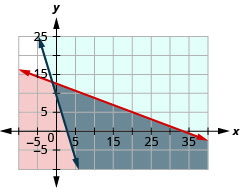
ⓒ yes
ⓓ no
Philip’s doctor tells him he should add at least 1,000 more calories per day to his usual diet. Philip wants to buy protein bars that cost ?1.80 each and have 140 calories and juice that costs ?1.25 per bottle and have 125 calories. He doesn’t want to spend more than ?12.
ⓐ Write a system of inequalities that models this situation.
ⓑ Graph the system.
ⓒ Can he buy 3 protein bars and 5 bottles of juice?
ⓓ Can he buy 5 protein bars and 3 bottles of juice?
ⓐ![]()
ⓑ
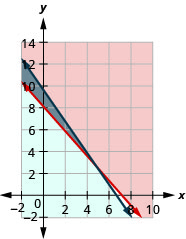
ⓒ yes
ⓓ no
Access these online resources for additional instruction and practice with solving systems of linear inequalities by graphing.
Key Concepts
- Solutions of a System of Linear Inequalities: Solutions of a system of linear inequalities are the values of the variables that make all the inequalities true. The solution of a system of linear inequalities is shown as a shaded region in the x, y coordinate system that includes all the points whose ordered pairs make the inequalities true.
- How to solve a system of linear inequalities by graphing.
- Graph the first inequality.
Graph the boundary line.
Shade in the side of the boundary line where the inequality is true.
- On the same grid, graph the second inequality.
Graph the boundary line.
Shade in the side of that boundary line where the inequality is true.
- The solution is the region where the shading overlaps.
- Check by choosing a test point.
- Graph the first inequality.
Section Exercises
Practice Makes Perfect
Determine Whether an Ordered Pair is a Solution of a System of Linear Inequalities
In the following exercises, determine whether each ordered pair is a solution to the system.
![]()
ⓐ![]()
ⓑ![]()
![]()
ⓐ![]()
ⓑ![]()
ⓐ false ⓑ true
![]()
ⓐ![]()
ⓑ![]()
![]()
ⓐ![]()
ⓑ![]()
ⓐ false ⓑ true
![]()
ⓐ![]()
ⓑ![]()
![]()
ⓐ![]()
ⓑ![]()
ⓐ false ⓑ true
Solve a System of Linear Inequalities by Graphing
In the following exercises, solve each system by graphing.
![]()
![]()
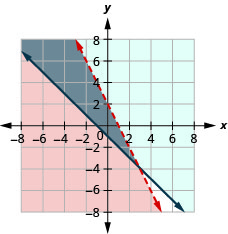
The solution is the grey region.
![]()
![]()
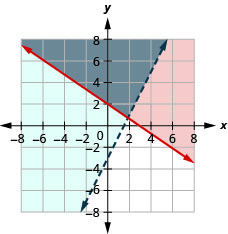
The solution is the grey region.
![]()
![]()
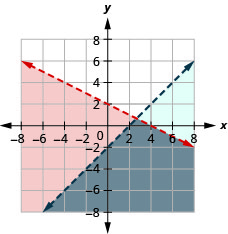
The solution is the grey region.
![]()
![]()
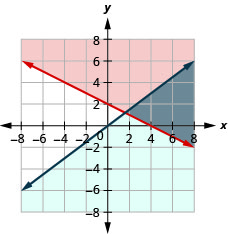
The solution is the grey region.
![]()
![]()

The solution is the grey region.
![]()
![]()
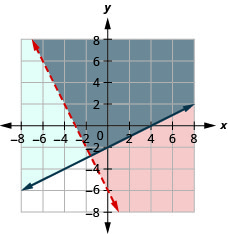
The solution is the grey region.
![]()
![]()
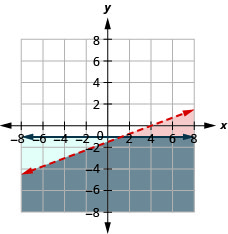
The solution is the grey region.
![]()
![]()
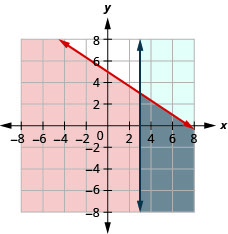
The solution is the grey region.
![]()
![]()
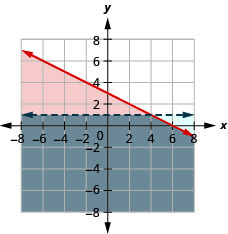
The solution is the grey region.
![]()
![]()
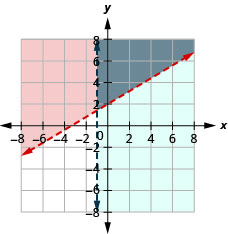
The solution is the grey region.
![]()
![]()
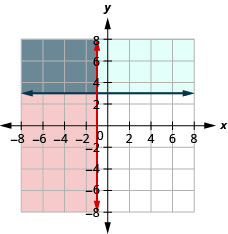
The solution is the grey region.
![]()
![]()
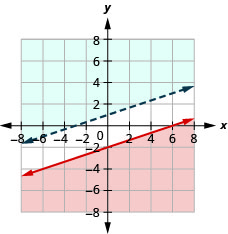
No solution.
![]()
![]()
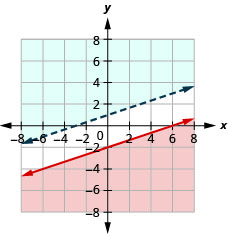
No solution.
![]()
![]()
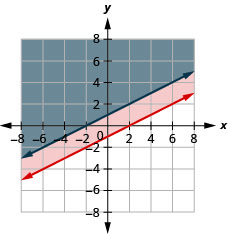
The solution is the grey region.
![]()
![]()
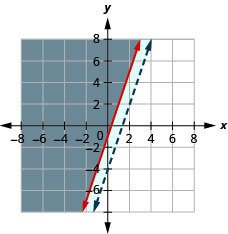
The solution is the grey region.
![]()
![]()
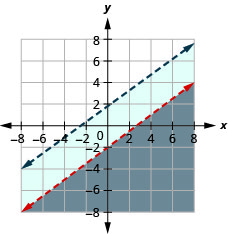
The solution is the grey region.
Solve Applications of Systems of Inequalities
In the following exercises, translate to a system of inequalities and solve.
Caitlyn sells her drawings at the county fair. She wants to sell at least 60 drawings and has portraits and landscapes. She sells the portraits for ?15 and the landscapes for ?10. She needs to sell at least ?800 worth of drawings in order to earn a profit.
ⓐ Write a system of inequalities to model this situation.
ⓑ Graph the system.
ⓒ Will she make a profit if she sells 20 portraits and 35 landscapes?
ⓓ Will she make a profit if she sells 50 portraits and 20 landscapes?
Jake does not want to spend more than ?50 on bags of fertilizer and peat moss for his garden. Fertilizer costs ?2 a bag and peat moss costs ?5 a bag. Jake’s van can hold at most 20 bags.
ⓐ Write a system of inequalities to model this situation.
ⓑ Graph the system.
ⓒ Can he buy 15 bags of fertilizer and 4 bags of peat moss?
ⓓ Can he buy 10 bags of fertilizer and 10 bags of peat moss?
ⓐ
ⓑ
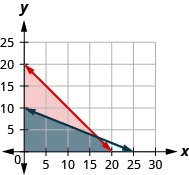
ⓒ yes
ⓓ no
Reiko needs to mail her Christmas cards and packages and wants to keep her mailing costs to no more than ?500. The number of cards is at least 4 more than twice the number of packages. The cost of mailing a card (with pictures enclosed) is ?3 and for a package the cost is ?7.
ⓐ Write a system of inequalities to model this situation.
ⓑ Graph the system.
ⓒ Can she mail 60 cards and 26 packages?
ⓓ Can she mail 90 cards and 40 packages?
Juan is studying for his final exams in chemistry and algebra. he knows he only has 24 hours to study, and it will take him at least three times as long to study for algebra than chemistry.
ⓐ Write a system of inequalities to model this situation.
ⓑ Graph the system.
ⓒ Can he spend 4 hours on chemistry and 20 hours on algebra?
ⓓ Can he spend 6 hours on chemistry and 18 hours on algebra?
ⓐ
ⓑ
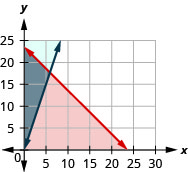
ⓒ yes
ⓓ no
Jocelyn is pregnant and so she needs to eat at least 500 more calories a day than usual. When buying groceries one day with a budget of ?15 for the extra food, she buys bananas that have 90 calories each and chocolate granola bars that have 150 calories each. The bananas cost ?0.35 each and the granola bars cost ?2.50 each.
ⓐ Write a system of inequalities to model this situation.
ⓑ Graph the system.
ⓒ Could she buy 5 bananas and 6 granola bars?
ⓓ Could she buy 3 bananas and 4 granola bars?
Mark is attempting to build muscle mass and so he needs to eat at least an additional 80 grams of protein a day. A bottle of protein water costs ?3.20 and a protein bar costs ?1.75. The protein water supplies 27 grams of protein and the bar supplies 16 gram. If he has ?10 dollars to spend
ⓐ Write a system of inequalities to model this situation.
ⓑ Graph the system.
ⓒ Could he buy 3 bottles of protein water and 1 protein bar?
ⓓ Could he buy no bottles of protein water and 5 protein bars?
ⓐ
ⓑ
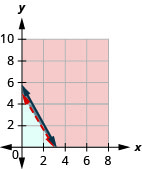
ⓒ no
ⓓ yes
Jocelyn desires to increase both her protein consumption and caloric intake. She desires to have at least 35 more grams of protein each day and no more than an additional 200 calories daily. An ounce of cheddar cheese has 7 grams of protein and 110 calories. An ounce of parmesan cheese has 11 grams of protein and 22 calories.
ⓐ Write a system of inequalities to model this situation.
ⓑ Graph the system.
ⓒ Could she eat 1 ounce of cheddar cheese and 3 ounces of parmesan cheese?
ⓓ Could she eat 2 ounces of cheddar cheese and 1 ounce of parmesan cheese?
Mark is increasing his exercise routine by running and walking at least 4 miles each day. His goal is to burn a minimum of 1500 calories from this exercise. Walking burns 270 calories/mile and running burns 650 calories.
ⓐ Write a system of inequalities to model this situation.
ⓑ Graph the system.
ⓒ Could he meet his goal by walking 3 miles and running 1 mile?
ⓓ Could he his goal by walking 2 miles and running 2 mile
ⓐ
ⓑ
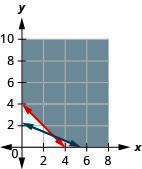
ⓒ no
ⓓ yes
Writing Exercises
Graph the inequality ![]() How do you know which side of the line
How do you know which side of the line ![]() should be shaded?
should be shaded?
Graph the system ![]() What does the solution mean?
What does the solution mean?
Answers will vary.
Self Check
ⓐ After completing the exercises, use this checklist to evaluate your mastery of the objectives of this section.
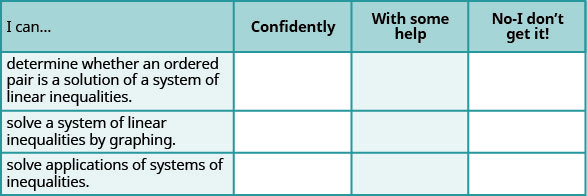
ⓑ What does this checklist tell you about your mastery of this section? What steps will you take to improve?
Chapter Review Exercises
Solve Systems of Linear Equations with Two Variables
Determine Whether an Ordered Pair is a Solution of a System of Equations.
In the following exercises, determine if the following points are solutions to the given system of equations.
![]()
ⓐ![]()
ⓑ![]()
![]()
ⓐ![]()
ⓑ![]()
ⓐ yes ⓑ no
Solve a System of Linear Equations by Graphing
In the following exercises, solve the following systems of equations by graphing.
![]()
![]()
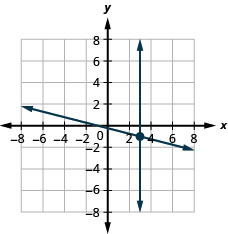
![]()
![]()
![]()
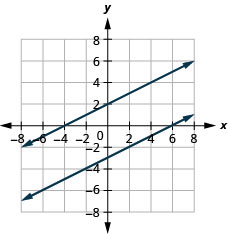
no solution
In the following exercises, without graphing determine the number of solutions and then classify the system of equations.
![]()
![]()
one solution, consistent system, independent equations
![]()
Solve a System of Equations by Substitution
In the following exercises, solve the systems of equations by substitution.
![]()
![]()
![]()
![]()
![]()
![]()
![]()
infinitely many solutions
Solve a System of Equations by Elimination
In the following exercises, solve the systems of equations by elimination
![]()
![]()
![]()
![]()
![]()
![]()
![]()
Choose the Most Convenient Method to Solve a System of Linear Equations
In the following exercises, decide whether it would be more convenient to solve the system of equations by substitution or elimination.
![]()
elimination
![]()
Solve Applications with Systems of Equations
Solve Direct Translation Applications
In the following exercises, translate to a system of equations and solve.
Mollie wants to plant 200 bulbs in her garden, all irises and tulips. She wants to plant three times as many tulips as irises. How many irises and how many tulips should she plant?
50 irises and 150 tulips
Ashanti has been offered positions by two phone companies. The first company pays a salary of ?22,000 plus a commission of ?100 for each contract sold. The second pays a salary of ?28,000 plus a commission of ?25 for each contract sold. How many contract would need to be sold to make the total pay the same?
Leroy spent 20 minutes jogging and 40 minutes cycling and burned 600 calories. The next day, Leroy swapped times, doing 40 minutes of jogging and 20 minutes of cycling and burned the same number of calories. How many calories were burned for each minute of jogging and how many for each minute of cycling?
10 calories jogging and 10 calories cycling
Troy and Lisa were shopping for school supplies. Each purchased different quantities of the same notebook and calculator. Troy bought four notebooks and five calculators for ?116. Lisa bought two notebooks and three calculators for ?68. Find the cost of each notebook and each thumb drive.
Solve Geometry Applications
In the following exercises, translate to a system of equations and solve.
The difference of two supplementary angles is 58 degrees. Find the measures of the angles.
119, 61
Two angles are complementary. The measure of the larger angle is five more than four times the measure of the smaller angle. Find the measures of both angles.
The measure of one of the small angles of a right triangle is 15 less than twice the measure of the other small angle. Find the measure of both angles.
![]() and
and ![]()
Becca is hanging a 28 foot floral garland on the two sides and top of a pergola to prepare for a wedding. The height is four feet less than the width. Find the height and width of the pergola.
The perimeter of a city rectangular park is 1428 feet. The length is 78 feet more than twice the width. Find the length and width of the park.
the length is 450 feet, the width is 264 feet
Solve Uniform Motion Applications
In the following exercises, translate to a system of equations and solve.
Sheila and Lenore were driving to their grandmother’s house. Lenore left one hour after Sheila. Sheila drove at a rate of 45 mph, and Lenore drove at a rate of 60 mph. How long will it take for Lenore to catch up to Sheila?
Bob left home, riding his bike at a rate of 10 miles per hour to go to the lake. Cheryl, his wife, left 45 minutes ![]() hour) later, driving her car at a rate of 25 miles per hour. How long will it take Cheryl to catch up to Bob?
hour) later, driving her car at a rate of 25 miles per hour. How long will it take Cheryl to catch up to Bob?
![]() an hour
an hour
Marcus can drive his boat 36 miles down the river in three hours but takes four hours to return upstream. Find the rate of the boat in still water and the rate of the current.
A passenger jet can fly 804 miles in 2 hours with a tailwind but only 776 miles in 2 hours into a headwind. Find the speed of the jet in still air and the speed of the wind.
the rate of the jet is 395 mph, the rate of the wind is 7 mph
Solve Mixture Applications with Systems of Equations
Solve Mixture Applications with Systems of Equations
For the following exercises, translate to a system of equations and solve.
Lynn paid a total of ?2,780 for 261 tickets to the theater. Student tickets cost ?10 and adult tickets cost ?15. How many student tickets and how many adult tickets did Lynn buy?
Priam has dimes and pennies in a cup holder in his car. The total value of the coins is ?4.21. The number of dimes is three less than four times the number of pennies. How many dimes and how many pennies are in the cup?
41 dimes and 11 pennies
Yumi wants to make 12 cups of party mix using candies and nuts. Her budget requires the party mix to cost her ?1.29 per cup. The candies are ?2.49 per cup and the nuts are ?0.69 per cup. How many cups of candies and how many cups of nuts should she use?
A scientist needs 70 liters of a 40% solution of alcohol. He has a 30% and a 60% solution available. How many liters of the 30% and how many liters of the 60% solutions should he mix to make the 40% solution?
![]() liters of 30% solution,
liters of 30% solution, ![]() liters of 60% solution
liters of 60% solution
Solve Interest Applications
For the following exercises, translate to a system of equations and solve.
Jack has ?12,000 to invest and wants to earn 7.5% interest per year. He will put some of the money into a savings account that earns 4% per year and the rest into CD account that earns 9% per year. How much money should he put into each account?
When she graduates college, Linda will owe ?43,000 in student loans. The interest rate on the federal loans is 4.5% and the rate on the private bank loans is 2%. The total interest she owes for one year was ?1,585. What is the amount of each loan?
?29,000 for the federal loan, ?14,000 for the private loan
Solve Systems of Equations with Three Variables
Solve Systems of Equations with Three Variables
In the following exercises, determine whether the ordered triple is a solution to the system.

ⓐ![]()
ⓑ![]()

ⓐ![]()
ⓑ![]()
ⓐ no ⓑ yes
Solve a System of Linear Equations with Three Variables
In the following exercises, solve the system of equations.


![]()


no solution

Solve Applications using Systems of Linear Equations with Three Variables
After attending a major league baseball game, the patrons often purchase souvenirs. If a family purchases 4 t-shirts, a cap and 1 stuffed animal their total is ?135. A couple buys 2 t-shirts, a cap and 3 stuffed animals for their nieces and spends ?115. Another couple buys 2 t-shirts, a cap and 1 stuffed animal and their total is ?85. What is the cost of each item?
25, 20, 15
Solve Systems of Equations Using Matrices
Write the Augmented Matrix for a System of Equations.
Write each system of linear equations as an augmented matrix.
![]()

![Rendered by QuickLaTeX.com \left[\begin{array}{cccccccccc}\hfill 4& & & \hfill 3& & & \hfill 0& & & \hfill -2\\ \hfill 1& & & \hfill -2& & & \hfill -3& & & \hfill 7\\ \hfill 2& & & \hfill -1& & & \hfill 2& & & \hfill -6\end{array}\right]](https://pressbooks.bccampus.ca/algebraintermediate/wp-content/ql-cache/quicklatex.com-847541d47daab64b78b2ef7a2a122111_l3.png)
Write the system of equations that that corresponds to the augmented matrix.
![]()
![Rendered by QuickLaTeX.com \left[\begin{array}{ccccccc}\hfill 1& & & \hfill 0& & & \hfill -3\\ \hfill 1& & & \hfill -2& & & \hfill 0\\ \hfill 0& & & \hfill -1& & & \hfill 2\end{array}\phantom{\rule{1em}{0ex}}|\phantom{\rule{1em}{0ex}}\begin{array}{c}\hfill -1\\ \hfill -2\\ \hfill 3\end{array}\right]](https://pressbooks.bccampus.ca/algebraintermediate/wp-content/ql-cache/quicklatex.com-1a5c89085f0c00c986105ad74e95119b_l3.png)

In the following exercises, perform the indicated operations on the augmented matrices.
![]()
ⓐ Interchange rows 2 and 1.
ⓑ Multiply row 1 by 4.
ⓒ Multiply row 2 by 3 and add to row 1.
![Rendered by QuickLaTeX.com \left[\begin{array}{ccccccc}1\hfill & & & \hfill -3& & & \hfill -2\\ 2\hfill & & & \hfill 2& & & \hfill -1\\ 4\hfill & & & \hfill -2& & & \hfill -3\end{array}\phantom{\rule{1em}{0ex}}|\phantom{\rule{1em}{0ex}}\begin{array}{c}\hfill 4\\ \hfill -3\\ \hfill -1\end{array}\right]](https://pressbooks.bccampus.ca/algebraintermediate/wp-content/ql-cache/quicklatex.com-88051c98b86b211e7bb10bc3b30971d3_l3.png)
ⓐ Interchange rows 2 and 3.
ⓑ Multiply row 1 by 2.
ⓒ Multiply row 3 by ![]() and add to row 2.
and add to row 2.
ⓐ![Rendered by QuickLaTeX.com \left[\begin{array}{cccccccccc}1\hfill & & & \hfill -3& & & \hfill -2& & & \hfill 4\\ 4\hfill & & & \hfill -2& & & \hfill -3& & & \hfill -1\\ 2\hfill & & & \hfill 2& & & \hfill -1& & & \hfill -3\end{array}\right]](https://pressbooks.bccampus.ca/algebraintermediate/wp-content/ql-cache/quicklatex.com-6ec62e3a43eb35b94109238378c3802d_l3.png)
ⓑ![Rendered by QuickLaTeX.com \left[\begin{array}{cccccccccc}2\hfill & & & \hfill -6& & & \hfill -4& & & \hfill 8\\ 4\hfill & & & \hfill -2& & & \hfill -3& & & \hfill -1\\ 2\hfill & & & \hfill 2& & & \hfill -1& & & \hfill -3\end{array}\right]](https://pressbooks.bccampus.ca/algebraintermediate/wp-content/ql-cache/quicklatex.com-c0d29d845afef1fdb502c58112db6d68_l3.png)
ⓒ![Rendered by QuickLaTeX.com \left[\begin{array}{cccccccccc}2\hfill & & & \hfill -6& & & \hfill -4& & & \hfill 8\\ 4\hfill & & & \hfill -2& & & \hfill -3& & & \hfill -1\\ 0\hfill & & & \hfill -6& & & \hfill -1& & & \hfill 5\end{array}\right]](https://pressbooks.bccampus.ca/algebraintermediate/wp-content/ql-cache/quicklatex.com-ef11c41011943a402cbeef8fad8bc7fa_l3.png)
Solve Systems of Equations Using Matrices
In the following exercises, solve each system of equations using a matrix.
![]()

![]()


no solution

Solve Systems of Equations Using Determinants
Evaluate the Determinant of a 2 × 2 Matrix
In the following exercise, evaluate the determinate of the square matrix.
![]()
![]()
Evaluate the Determinant of a 3 × 3 Matrix
In the following exercise, find and then evaluate the indicated minors.
 Find the minor ⓐ
Find the minor ⓐ ![]() ⓑ
ⓑ ![]() ⓒ
ⓒ ![]()
In the following exercise, evaluate each determinant by expanding by minors along the first row.

21
In the following exercise, evaluate each determinant by expanding by minors.

Use Cramer’s Rule to Solve Systems of Equations
In the following exercises, solve each system of equations using Cramer’s rule
![]()
![]()


![]()


inconsistent
Solve Applications Using Determinants
In the following exercises, determine whether the given points are collinear.
![]()
![]() and
and ![]()
Graphing Systems of Linear Inequalities
Determine Whether an Ordered Pair is a Solution of a System of Linear Inequalities
In the following exercises, determine whether each ordered pair is a solution to the system.
![]()
ⓐ![]()
ⓑ![]()
ⓐ yes ⓑ no
![]()
ⓐ![]()
ⓑ![]()
Solve a System of Linear Inequalities by Graphing
In the following exercises, solve each system by graphing.
![]()
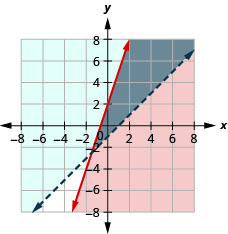
The solution is the grey region.
![]()
![]()
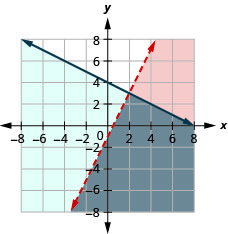
The solution is the grey region.
![]()
![]()
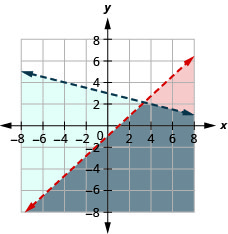
No solution.
![]()
Solve Applications of Systems of Inequalities
In the following exercises, translate to a system of inequalities and solve.
Roxana makes bracelets and necklaces and sells them at the farmers’ market. She sells the bracelets for ?12 each and the necklaces for ?18 each. At the market next weekend she will have room to display no more than 40 pieces, and she needs to sell at least ?500 worth in order to earn a profit.
ⓐ Write a system of inequalities to model this situation.
ⓑ Graph the system.
ⓒ Should she display 26 bracelets and 14 necklaces?
ⓓ Should she display 39 bracelets and 1 necklace?
ⓐ
ⓑ
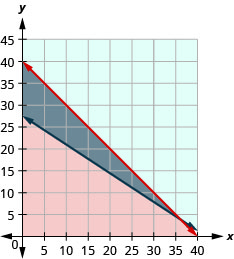
ⓒ yes
ⓓ no
Annie has a budget of ?600 to purchase paperback books and hardcover books for her classroom. She wants the number of hardcover to be at least 5 more than three times the number of paperback books. Paperback books cost ?4 each and hardcover books cost ?15 each.
ⓐ Write a system of inequalities to model this situation.
ⓑ Graph the system.
ⓒ Can she buy 8 paperback books and 40 hardcover books?
ⓓ Can she buy 10 paperback books and 37 hardcover books?
Chapter Practice Test
In the following exercises, solve the following systems by graphing.
![]()
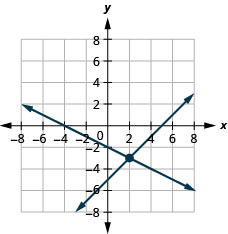
![]()
![]()
In the following exercises, solve each system of equations. Use either substitution or elimination.
![]()
![]()
![]()

![]()
Solve the system of equations using a matrix.
![]()

![]()
Solve using Cramer’s rule.
![]()
Evaluate the determinant by expanding by minors:

![]()
In the following exercises, translate to a system of equations and solve.
Greg is paddling his canoe upstream, against the current, to a fishing spot 10 miles away. If he paddles upstream for 2.5 hours and his return trip takes 1.25 hours, find the speed of the current and his paddling speed in still water.
A pharmacist needs 20 liters of a 2% saline solution. He has a 1% and a 5% solution available. How many liters of the 1% and how many liters of the 5% solutions should she mix to make the 2% solution?
15 liters of 1% solution, 5 liters of 5% solution
Arnold invested ?64,000, some at 5.5% interest and the rest at 9%. How much did he invest at each rate if he received ?4,500 in interest in one year?
The church youth group is selling snacks to raise money to attend their convention. Amy sold 2 pounds of candy, 3 boxes of cookies and 1 can of popcorn for a total sales of ?65. Brian sold 4 pounds of candy, 6 boxes of cookies and 3 cans of popcorn for a total sales of ?140. Paulina sold 8 pounds of candy, 8 boxes of cookies and 5 can of popcorn for a total sales of ?250. What is the cost of each item?
The candy cost ?20; the cookies cost ?5; and the popcorn cost ?10.
The manufacturer of a granola bar spends ?1.20 to make each bar and sells them for ?2. The manufacturer also has fixed costs each month of ?8,000.
ⓐ Find the cost function C when x granola bars are manufactured
ⓑ Find the revenue function R when x granola bars are sold.
ⓒ Show the break-even point by graphing both the Revenue and Cost functions on the same grid.
ⓓ Find the break-even point. Interpret what the break-even point means.
Translate to a system of inequalities and solve.
Andi wants to spend no more than ?50 on Halloween treats. She wants to buy candy bars that cost ?1 each and lollipops that cost ?0.50 each, and she wants the number of lollipops to be at least three times the number of candy bars.
ⓐ Write a system of inequalities to model this situation.
ⓑ Graph the system.
ⓒ Can she buy 20 candy bars and 40 lollipops?
ⓐ
ⓑ
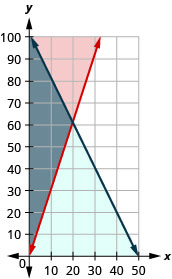
ⓒ no
ⓓ yes
Glossary
- system of linear inequalities
- Two or more linear inequalities grouped together form a system of linear inequalities.

